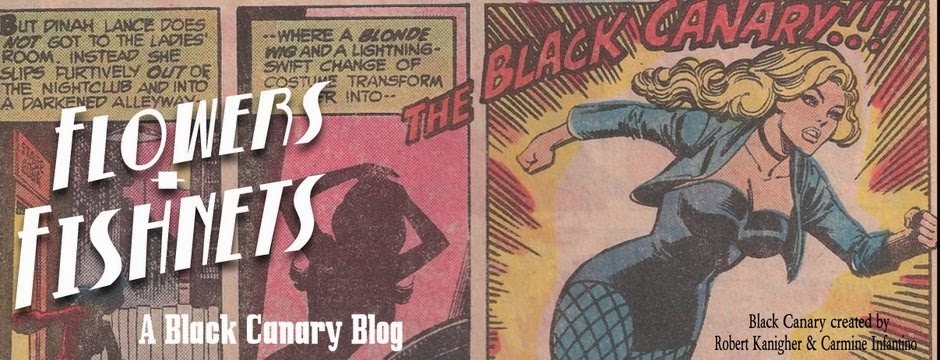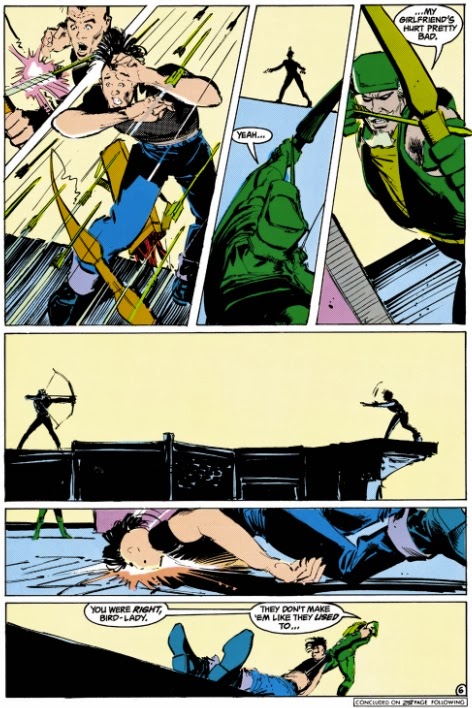Four months after the publication of the one-shot
Birds of Prey: Revolution, the continuing, albeit sporadic-at-the-time, partnership of Black Canary and Oracle returned for another one-off story that looked like it would kill the series before it really started.
Series creator Chuck Dixon scripts Birds of Prey: Wolves with the fourth interior artist in as many stories. The only commonality between the original BoP special, the "Manhunt" miniseries, "Revolution" and now "Wolves" is the sweet cover art by Gary Frank. The artist proving interiors this time was no fresh-faced kid but rather longtime comics veteran and one-time vice president of DC, Dick Giordano. Giordano, of course, had a pretty familiar history with Black Canary over the years as both an inker and penciler--and I'm sure I'll get to most or all of those renderings eventually.
The last time we saw Black Canary and Oracle at the end of their mission to Santa Prisca, the ladies weren't doing too well in their professional relationship. Oracle has a serious problem with Canary's
freestyle form of operation, which frequently leads her into greater danger. Dinah's improvisational approach to her missions, on the other hand, resulted in greater gains for the good guys and more damage to the bad guys. They have a legitimate philosophical difference, exacerbated by the fact that Oracle thinks of Canary as her agent--that Canary works for her.
This grievance spills over into the current mission, where Black Canary is fighting for her life against some reprogrammed construction robots in a Kozuitu automotive factory. A Japanese terrorist group has taken over the plant. Canary is dodging the deadly robots, asking Oracle to shut them down via her mastery of all things electronic. Oracle chastises her for her stubborn refusal to comprehend basic computer systems.
At the last second, Oracle takes control of the engineering robots and turns them against Hodo, the leader of the terror group. Black Canary keeps her down and then oversees the police mopping up the terrorists.
But while Canary's fight with deadly arc-welders is over, her fight with Oracle is just heating up.
Oracle criticizes Black Canary's lack of preparation before going into battle as a result of her time spent with Oliver Queen, the Green Arrow. Canary defends Ollie's staunch liberalism and suggests that if she and Oracle are at such ideological odds, maybe they should take a break from each other.
Yep. They break up.
Dinah takes her earrings and necklace comms devices and Barbara loses her appetite.
Later, Dinah Lance goes to a video store, flirts with the store clerk just enough to make him uncomfortable, and rents a classic movie that promptly puts her to sleep as soon as she gets home. She's woken by a knock at the door... and the last man she expected to see.
Er, what? Dinah was married?!! To a guy named Windrow?
Meanwhile, Barbara Gordon goes shopping at a bookstore and lashes out at the clerk who offers to help, because being in a wheelchair doesn't make Babs helpless. Her response to the woman is a little more than defensive; it's harsh. As Babs goes to her car, she's accosted by a trio of muggers who want to take her ride. And not the wheelchair.
Back in Dinah's apartment, we learn a little about Craig Windrow, Dinah's ex-husband. They were married very briefly in college, and he was pretty much a loser then. But it looks like getting dumped by Dinah was the kick in the butt Craig needed to get some focus. Now he runs an accounting firm and his life seems to be on track.
Except for that the Ukrainian mafia wants to kill him.
Meanwhile, Babs puts the beatdown on her would-be assailants, until one of them hits her with a trashcan, pushing her chair into the street in the way of oncoming traffic. A speeding car slams on the brakes but still hits her chair, sending Babs sprawling onto the street.
The driver gets out of the car and helps her while cops pursue the muggers. Babs is shaken and embarrassed, but the driver who struck her is a beautiful adonis named Drew Fahrnum, so that kind of makes up for almost dying. He offers to take her to lunch and she accepts. He seems way too clean and handsome to be true.
Back at Dinah's place, she has changed out of her bathrobe but into civilian clothes. She and Craig race out of her apartment as the Ukranian hoods throw grenades, shoot guns, and drive cars at them.
During her lunch date with Drew, Babs admits to having a fight with her friend/coworker, and that it's kind of spoiled her mood all day. But she's starting to reassess her view on the working relationship she has with Dinah. She even refers to Dinah as "labor" and herself as "management." Meanwhile, Drew listens to all of this attentively and says the appropriately charming things at the right times.
He's definitely bad.
Dinah and Craig race across the subway platform and jump into a train just as its leaving the station. For now, they seem to have eluded the hoods chasing them. Dinah asks once again what Craig did to earn a death mark. He insists that they were a client until he found out what they really represented and when he tried to sever the deal, they started threatening him.
Craig apologizes for getting Dinah mixed up in his dangerous life, but she accepts it. She has a weakness for dangerous men and/or fools, and she's happy he turned to her for help after all these years. They kiss and it seems like they will be rekindling their relationship.
Babs and Mr. Too-Good-To-Be-Drew continue their date as he walks her home, then invites himself up to her apartment. When they get there, however, the three muggers who tried to take her van earlier that day are waiting. They work for Drew as part of his way too elaborate plan that makes absolutely not goddamn sense.
On the subway, the Ukrainian hoods catches Dinah and Craig and they reveal that Craig actually stole a computer file with the mob's bank codes and accounts and access to billions of their untraceable money. Dinah doesn't appreciate being used.
She pounds the hoods into unconsciousness, and then confronts Craig. He admits to taking the mob's money and then using her for protection, but offers to split the blood money with her. She throws a pistol that knocks him out.
Meanwhile, Babs shuts the lights down in her apartment and proceeds to take down all four of her intruders in the dark using night vision goggles and some handy little weapons (and misdirection). When the Gotham City Police show up to investigate how the four criminals ended up captured, Babs says it must have been Batman.
Later, Dinah puts her comms devices back on and reunites with Oracle.
For Black Canary fans, the biggest thing to come out of this issue is the revelation that Dinah Lance was married ever-so briefly when she was in college. And that her husband was not a member of the costumed community. He was just a young loser who grew up to become a slightly older loser. He'd never been mentioned before, nor will he be shown again until a decade later in Black Canary's second miniseries.
Besides that, the story was flimsy. This was basically Chuck Dixon spending some downtime with the ladies whilst showing that these women never have any true downtime. The men they're attracted to--the men they fall for--are bad for them, so the safest most compatible relationship is actually with each other and their crime fighting partnership. They had better settle their philosophical differences and learn to work together because everyone else will let them down.
That's kind of the message Dixon is presenting here, but I don't think I buy it. I have no idea why Barbara would be so trusting of this Drew guy right away, but what's beyond that is the absurdity that is his real criminal nature. The three hoods work for him? So he arranged for them to rob the wheelchair woman's special van? Did he know that she would kick their asses? How did he know she would end up in the street in front of his car, and how did he know he wouldn't drive over her and kill her? Why would he bother taking her out to dinner to rob her apartment later? How would he know what kind of valuable stuff is there that it would be worth the time and preparation for this ridiculous plot?
Dinah, likewise, comes off as equally naive by trusting her loser ex-husband yet again. I get that she has a soft spot for a certain kind of man, and that some people have blinders on when it comes to exes, but she should have spotted his lies a mile away. It also feels too contrived that she just happened to have an ex-husband we've never seen or heard of before.
The art is decent but nothing spectacular. Dick Giordano drew some freakin' gorgeous Black Canary stories. At this later stage of his career, his work wasn't as impressive. On the other hand, he didn't have much to work with. Dinah is only in her Black Canary costume (even though I don't like that version of her costume) for the first couple pages and the action beats are pretty pedestrian.
Birds of Prey: Wolves isn't a bad comic, but it's by far the weakest entry in the series up to this point.
Come back next Tuesday for the next one-shot in the series, featuring the team-up of Black Canary and... Batgirl?!!
























































